Temperate collections
Au jardin botanique Jean-Marie Pelt, ce sont près de 12 000 espèces que l’on peut découvrir, dans un jardin de 25 hectares et 2500 m2 de serres tropicales. Plantes rares et menacées, plantes étonnantes ou insolites sont en culture dans l’un des plus grands jardins botaniques de France.
Un vrai musée vivant de la botanique !
Back
to
top
The Evolution Garden, before flowering plants
The Evolution Garden, before flowering plants
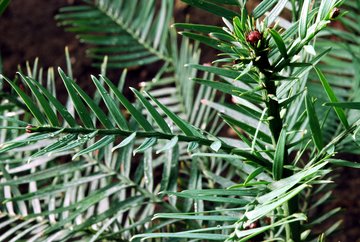
Nestled within the environment of a conifer collection, this collection presents the evolution of plants before the appearance of flowering plants.
Located near the Botanical Garden entrance, it tells the story of plants since the origin of life, showing distinctive groups of plants, such as charophytes, mosses or ferns, as well as Cycas or Ginkgo biloba.
To discover the history of flowering plants, go to the second part " The Evolution Garden" in the heart of the Botanical Garden.

Nestled within the environment of a conifer collection, this collection presents the evolution of plants before the appearance of flowering plants.
Located near the Botanical Garden entrance, it tells the story of plants since the origin of life, showing distinctive groups of plants, such as charophytes, mosses or ferns, as well as Cycas or Ginkgo biloba.
To discover the history of flowering plants, go to the second part " The Evolution Garden" in the heart of the Botanical Garden.
The Natural Garden
The Natural Garden
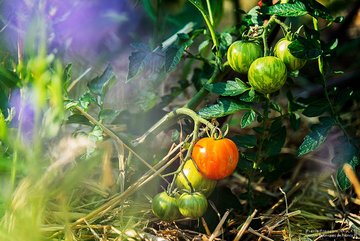
This area presents different ecological gardening techniques: mulching, lasagna gardening, etc. It is the dedicated place for gardening courses and other educational workshops, but also the area where the “composting hens” live.

This area presents different ecological gardening techniques: mulching, lasagna gardening, etc. It is the dedicated place for gardening courses and other educational workshops, but also the area where the “composting hens” live.
History of Cultivated Plants
History of Cultivated Plants
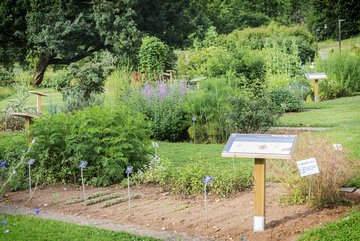
The History of Cultivated Plants is a collection that gives you an overview of:
- The plants grown by Mankind, from the Neolithic period (circa 3,500 years B.C.) to the present day. Indeed, Mankind has always exploited natural plant resources to meet its many needs: food, medicine, construction…
Barley, flax, peas, parsley, turnips, oats, onions, rye, vetch, broad beans, lentils, carrots, parsnips, garlic, shallots, wormwood, matricaria, tansy, asparagus, lamb’s lettuce, lemon balm, rhubarb, peppers, tomatoes, potatoes, beans, corn, sunflower, squash... are just a few examples of all the species presented. - Weed species introduced by accident from the 16th century onwards together with other plants. Examples include the American amaranths, horseweed (Erigeron canadensis), Himalayan balsam, and goldenrod. Some of these plants are nowadays labeled invasive, i.e. they grow to the detriment of native plants.
- Ornamental plants cultivated since the beginning of the 16th century. They are grouped chronologically according to their first use or introduction. This section illustrates the growing interest in garden ornamentation since the Renaissance.

The History of Cultivated Plants is a collection that gives you an overview of:
- The plants grown by Mankind, from the Neolithic period (circa 3,500 years B.C.) to the present day. Indeed, Mankind has always exploited natural plant resources to meet its many needs: food, medicine, construction…
Barley, flax, peas, parsley, turnips, oats, onions, rye, vetch, broad beans, lentils, carrots, parsnips, garlic, shallots, wormwood, matricaria, tansy, asparagus, lamb’s lettuce, lemon balm, rhubarb, peppers, tomatoes, potatoes, beans, corn, sunflower, squash... are just a few examples of all the species presented. - Weed species introduced by accident from the 16th century onwards together with other plants. Examples include the American amaranths, horseweed (Erigeron canadensis), Himalayan balsam, and goldenrod. Some of these plants are nowadays labeled invasive, i.e. they grow to the detriment of native plants.
- Ornamental plants cultivated since the beginning of the 16th century. They are grouped chronologically according to their first use or introduction. This section illustrates the growing interest in garden ornamentation since the Renaissance.
The Lorraine Horticultural Heritage
The Lorraine Horticultural Heritage
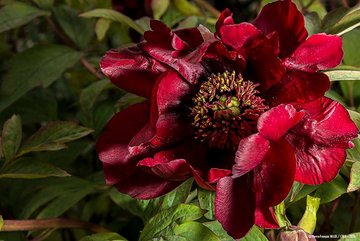
The collection, dedicated to the horticultural varieties growing in Lorraine, aims at gathering all the varieties bred by the Lorraine horticulturalists between the mid-19th and the mid-20th centuries.
Thanks to extensive bibliographic work, meticulous research, and numerous contacts with professionals (nurseries, arboreta, botanical gardens, etc.) from France and across the world, a large number of lilacs, syringas, deutzias, weigelas, peonies and fuchsias are now being grown at the Jean-Marie Pelt Botanical Garden.
This collection has been awarded the “Collection Nationale” label by the French Council for the Conservation of Plants and Gardens (Conservatoire des Collections Végétales Spécialisées, CCVS).

The collection, dedicated to the horticultural varieties growing in Lorraine, aims at gathering all the varieties bred by the Lorraine horticulturalists between the mid-19th and the mid-20th centuries.
Thanks to extensive bibliographic work, meticulous research, and numerous contacts with professionals (nurseries, arboreta, botanical gardens, etc.) from France and across the world, a large number of lilacs, syringas, deutzias, weigelas, peonies and fuchsias are now being grown at the Jean-Marie Pelt Botanical Garden.
This collection has been awarded the “Collection Nationale” label by the French Council for the Conservation of Plants and Gardens (Conservatoire des Collections Végétales Spécialisées, CCVS).
The Ornamental Garden
The Ornamental Garden
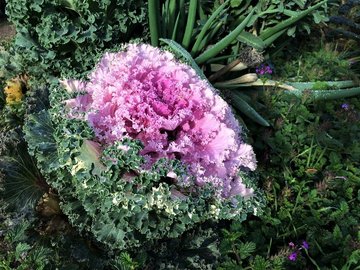
Located at the far end of the collection dedicated to the history of cultivated plants, this garden is both:
- informative, thanks to its variety of plants, such as old varieties little known to the general public
- but also enjoyable because of its original scenes that are renewed every year.

Located at the far end of the collection dedicated to the history of cultivated plants, this garden is both:
- informative, thanks to its variety of plants, such as old varieties little known to the general public
- but also enjoyable because of its original scenes that are renewed every year.
The Ecosystems in Lorraine
The Ecosystems in Lorraine
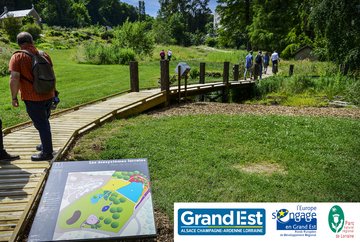
In partnership with the Lorraine Regional Nature Reserve (Parc naturel régional de Lorraine, avec le soutien de la Région Grand Est et de l’Union européenne) the Jean-Marie Pelt Botanical Garden gives you an overview of the biodiversity in Lorraine, following nine stages. With each of them, you will discover a natural or man-made environment typical of the Lorraine Plateau (a territory limited to the east by the Vosges mountains and to the west by the Forest of Argonne), with its distinctive flora and fauna, but also its history.
Through these ecosystems recreated within the Botanical Garden, the visitor is encouraged to enjoy a ‘life-size’ experience in the heart of the Regional Nature Reserve.

In partnership with the Lorraine Regional Nature Reserve (Parc naturel régional de Lorraine, avec le soutien de la Région Grand Est et de l’Union européenne) the Jean-Marie Pelt Botanical Garden gives you an overview of the biodiversity in Lorraine, following nine stages. With each of them, you will discover a natural or man-made environment typical of the Lorraine Plateau (a territory limited to the east by the Vosges mountains and to the west by the Forest of Argonne), with its distinctive flora and fauna, but also its history.
Through these ecosystems recreated within the Botanical Garden, the visitor is encouraged to enjoy a ‘life-size’ experience in the heart of the Regional Nature Reserve.
Alpine Garden
Alpine Garden
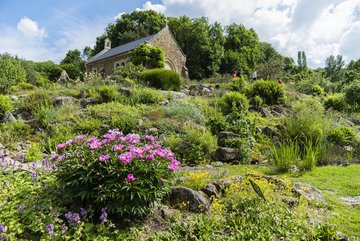
With more than 1,200 species, the Alpine Garden in the Jean-Marie Pelt Botanical Garden is one of the largest French collections of mountain plants cultivated at low altitude.
It is presented as a succession of small rock gardens, each of them dedicated to a mountainous region of the globe. Saxifrages, Edelweiss, Penstemons, and many other mountain plants make this a unique collection.
The Alpine Garden contains plants mainly from the lower alpine regions – growing at lower altitudes and in a milder climate than true alpine plants – are presented. Indeed, the climatic conditions in Nancy are different from those required for the survival of high mountain plants. Also, to complete your visit, go to the Haut Chitelet High Altitude Garden in Xonrupt-Longemer. Located at an altitude of more than 1, 200 m, it is home to more than 2,500 high mountain varieties.

With more than 1,200 species, the Alpine Garden in the Jean-Marie Pelt Botanical Garden is one of the largest French collections of mountain plants cultivated at low altitude.
It is presented as a succession of small rock gardens, each of them dedicated to a mountainous region of the globe. Saxifrages, Edelweiss, Penstemons, and many other mountain plants make this a unique collection.
The Alpine Garden contains plants mainly from the lower alpine regions – growing at lower altitudes and in a milder climate than true alpine plants – are presented. Indeed, the climatic conditions in Nancy are different from those required for the survival of high mountain plants. Also, to complete your visit, go to the Haut Chitelet High Altitude Garden in Xonrupt-Longemer. Located at an altitude of more than 1, 200 m, it is home to more than 2,500 high mountain varieties.
Preservation Orchard
Preservation Orchard
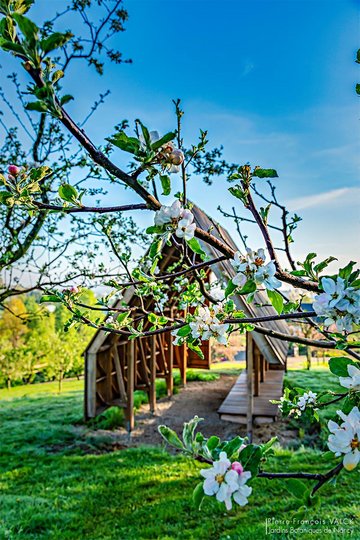
The preservation orchard is located behind Sainte-Valérie Chapel. It includes 46 heirloom apple varieties, such as Lorraine’s heritage varieties (whose departmental origins are specified on the labels), and others that are considered worthy, including some well-known ones, like the "Reine des reinettes" and the "Pomme d'api".
As with all the collections, they are cultivated with no pesticides in an environmentally-friendly way.

The preservation orchard is located behind Sainte-Valérie Chapel. It includes 46 heirloom apple varieties, such as Lorraine’s heritage varieties (whose departmental origins are specified on the labels), and others that are considered worthy, including some well-known ones, like the "Reine des reinettes" and the "Pomme d'api".
As with all the collections, they are cultivated with no pesticides in an environmentally-friendly way.
The Evolution Garden, flowering plants
The Evolution Garden, flowering plants
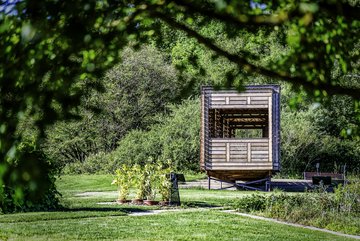
The purpose of the evolution garden is to highlight the lineage between plant species by presenting a classification of plants. It constitutes a "family tree" of flowering plants.
This collection, which was renewed between 2018 and 2020, is based on the system proposed by the Angiosperm Phylogeny Group in 2016, which is the result of the collaborative work of many international researchers.
From the circular starting point of the collection*, a pattern of alleys representing ramification branches starts out. These alleys allow visitors to discover and follow the evolution and changes that have occurred over time in the different plant groups. Educational materials are provided to the visitor.
*Located at the Ramificarré microarchitecture, which offers a panoramic view of the garden

The purpose of the evolution garden is to highlight the lineage between plant species by presenting a classification of plants. It constitutes a "family tree" of flowering plants.
This collection, which was renewed between 2018 and 2020, is based on the system proposed by the Angiosperm Phylogeny Group in 2016, which is the result of the collaborative work of many international researchers.
From the circular starting point of the collection*, a pattern of alleys representing ramification branches starts out. These alleys allow visitors to discover and follow the evolution and changes that have occurred over time in the different plant groups. Educational materials are provided to the visitor.
*Located at the Ramificarré microarchitecture, which offers a panoramic view of the garden
Arboretum
Arboretum
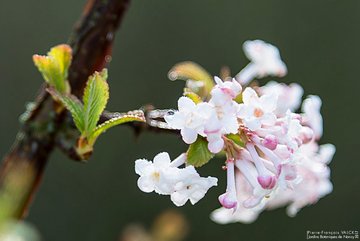
An arboretum is a collection of woody plants, including trees and shrubs. The collection at the Jean-Marie Pelt Botanical Garden illustrates the forest vegetation of temperate climate regions by geographical origin, from west to east, following the reading of a planisphere. The circular-shaped arboretum starts above the rose garden with American species and ends at the Alpine garden with Asian species.

An arboretum is a collection of woody plants, including trees and shrubs. The collection at the Jean-Marie Pelt Botanical Garden illustrates the forest vegetation of temperate climate regions by geographical origin, from west to east, following the reading of a planisphere. The circular-shaped arboretum starts above the rose garden with American species and ends at the Alpine garden with Asian species.
Rhododendron Valley
Rhododendron Valley
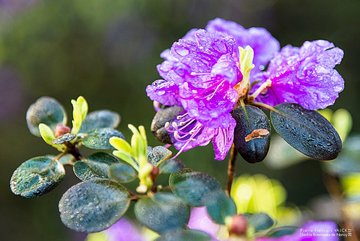
This valley is home to rhododendrons and other plants such as ferns, hostas and hydrangeas that appreciate the coolness of the place.
Alongside them, there are rare or original species of conifers such as the Cunninghamia or the Picea chihuahuana from Mexico.

This valley is home to rhododendrons and other plants such as ferns, hostas and hydrangeas that appreciate the coolness of the place.
Alongside them, there are rare or original species of conifers such as the Cunninghamia or the Picea chihuahuana from Mexico.
Bamboo Forest
Bamboo Forest
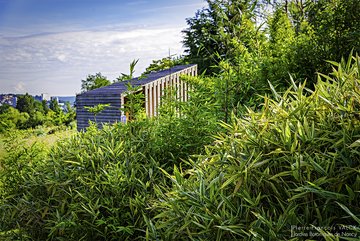
This collection from the Botanical Garden takes you on a journey to Asia through various amazing plants known for their rapid growth. The bamboo "forest" is actually a meadow planted with giant grasses, as they are in the Poaceae family, like cereals and other grasses.
Although many species are also to be found in America and some on other continents, the Botanical Garden has chosen to present Asian bamboos only, through a collection of 28 taxa. Phyllostachys, Pleioblastus and other varieties were initially planted to test the hardiness of specific species. First grown near the entrance, the bamboos were transplanted in 2010 to another area of the garden.

This collection from the Botanical Garden takes you on a journey to Asia through various amazing plants known for their rapid growth. The bamboo "forest" is actually a meadow planted with giant grasses, as they are in the Poaceae family, like cereals and other grasses.
Although many species are also to be found in America and some on other continents, the Botanical Garden has chosen to present Asian bamboos only, through a collection of 28 taxa. Phyllostachys, Pleioblastus and other varieties were initially planted to test the hardiness of specific species. First grown near the entrance, the bamboos were transplanted in 2010 to another area of the garden.
The Flower Garden
The Flower Garden
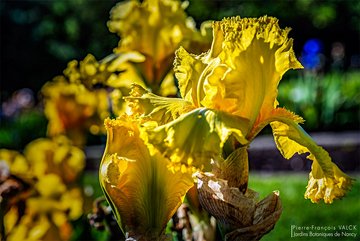
In the centre of the Jean-Marie Pelt Botanical Garden, dahlias, irises and daylilies are alternately displayed in long flowerbeds, creating a palette of colors that change with the seasons. Thanks to the combination of these different plants, there are flowers from May until the first frost.
The irises and daylilies are not randomly planted… They are arranged in chronological order of acquisition: between 1840 and 1995 for the irises and between 1939 and 1994 for the daylilies.

In the centre of the Jean-Marie Pelt Botanical Garden, dahlias, irises and daylilies are alternately displayed in long flowerbeds, creating a palette of colors that change with the seasons. Thanks to the combination of these different plants, there are flowers from May until the first frost.
The irises and daylilies are not randomly planted… They are arranged in chronological order of acquisition: between 1840 and 1995 for the irises and between 1939 and 1994 for the daylilies.
Medicinal plants
Medicinal plants
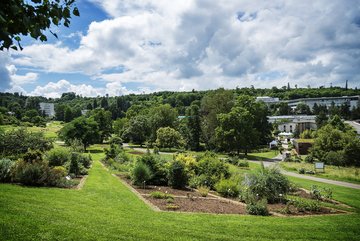
Designed in the early 1980s like a painter's palette, and inspired by Paul Klee or Mondrian, the collection of medicinal plants was rearranged in 2007 after the thesis work of a student in pharmacy.
The plants are classified according to an activity-toxicity gradient: from toxic plants to plants that are sources of therapeutic molecules, then to plants used in phytotherapy.
In the area dedicated to toxic plants, morphologically similar plants are presented side by side to highlight their differences. Indeed, it is necessary to pay particular attention to the real identity of the plants in order not to confuse a toxic plant with a non-toxic plant.
Flash the QR codes and discover the characteristics of a hundred plants with the “Smart Jardin” application!

Designed in the early 1980s like a painter's palette, and inspired by Paul Klee or Mondrian, the collection of medicinal plants was rearranged in 2007 after the thesis work of a student in pharmacy.
The plants are classified according to an activity-toxicity gradient: from toxic plants to plants that are sources of therapeutic molecules, then to plants used in phytotherapy.
In the area dedicated to toxic plants, morphologically similar plants are presented side by side to highlight their differences. Indeed, it is necessary to pay particular attention to the real identity of the plants in order not to confuse a toxic plant with a non-toxic plant.
Flash the QR codes and discover the characteristics of a hundred plants with the “Smart Jardin” application!
The Rose Garden
The Rose Garden
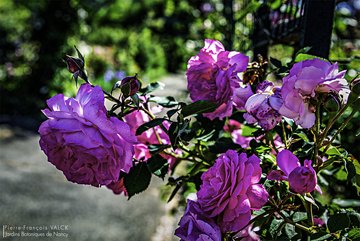
Known and used to decorate gardens for several millennia, roses are undoubtedly one of the most appreciated flowers for their bloom and fragrance.
The Rose Garden of the Jean-Marie Pelt Botanical Garden offers a range of varieties from the hardiest roses to contemporary cultivars.
In recent years, this collection has been enhanced with perennials, such as geraniums, yarrow, daylilies and irises that are home to numerous auxiliary insects which act as a natural defence against pests.

Known and used to decorate gardens for several millennia, roses are undoubtedly one of the most appreciated flowers for their bloom and fragrance.
The Rose Garden of the Jean-Marie Pelt Botanical Garden offers a range of varieties from the hardiest roses to contemporary cultivars.
In recent years, this collection has been enhanced with perennials, such as geraniums, yarrow, daylilies and irises that are home to numerous auxiliary insects which act as a natural defence against pests.
The Lorraine Meadow
The Lorraine Meadow
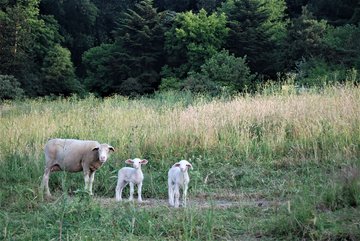
In Lorraine (north east of France), the surface area of permanent grassland has been steadily shrinking over the past few decades, due to the increase of agricultural lands or because of urbanisation.
At the Jean-Marie Pelt Botanical Garden, we have decided to keep the large grassy area that overlooks the garden and to develop its biodiversity. To this end, the meadow is actively grazed by sheep in order to obtain a meadow pasture.

In Lorraine (north east of France), the surface area of permanent grassland has been steadily shrinking over the past few decades, due to the increase of agricultural lands or because of urbanisation.
At the Jean-Marie Pelt Botanical Garden, we have decided to keep the large grassy area that overlooks the garden and to develop its biodiversity. To this end, the meadow is actively grazed by sheep in order to obtain a meadow pasture.
Dune
Dune
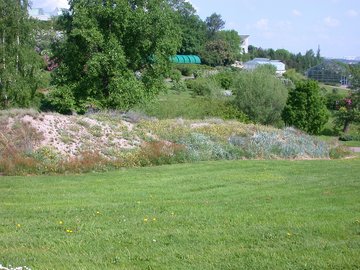
The reconstructed dune, far from its natural conditions, aims to present some of the most characteristic species of the dune vegetation of the Atlantic coast, such as Agropyrum junceum (sand dog tooth), Ammophila arenaria (marram grass), Eryngium maritimum (sea holly), Glaucium flavum (yellow horned poppy), or Hippophae rhamnoides (sea buckthorn).

The reconstructed dune, far from its natural conditions, aims to present some of the most characteristic species of the dune vegetation of the Atlantic coast, such as Agropyrum junceum (sand dog tooth), Ammophila arenaria (marram grass), Eryngium maritimum (sea holly), Glaucium flavum (yellow horned poppy), or Hippophae rhamnoides (sea buckthorn).
The Lorraine Forest
The Lorraine Forest
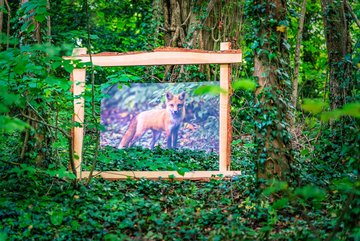
The forest is one of the most remarkable natural environments in Lorraine. It covers approximately 35% of the territory. This ecosystem is extremely rich, both in terms of its wood, and its fauna and flora.
The forest trail that you are about to follow will help you discover some of the species found in the Lorraine forest, and will tell you about its history, evolution and functioning.
All along the trail, visitors are invited to discover the wildlife of the Grand Est region. This trail was created with the Lorraine Regional Nature Reserve.

The forest is one of the most remarkable natural environments in Lorraine. It covers approximately 35% of the territory. This ecosystem is extremely rich, both in terms of its wood, and its fauna and flora.
The forest trail that you are about to follow will help you discover some of the species found in the Lorraine forest, and will tell you about its history, evolution and functioning.
All along the trail, visitors are invited to discover the wildlife of the Grand Est region. This trail was created with the Lorraine Regional Nature Reserve.
Citrus
Citrus
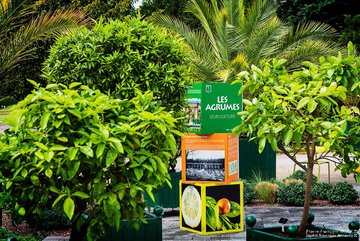
In summer, 27 varieties of citrus trees such as lemon, orange and other tangerine trees adorn the paved square at the entrance to the garden and the path leading to the greenhouses.
But during the winter months, they are sheltered in an orangery at the entrance to the tropical greenhouses. In late summer and autumn, their blossoms give off a heady scent that delights the senses. Winter is the fruiting period.
In addition to the well-known plants, such as the famous bergamot tree, visitors will be impressed by the atypical fruiting of the kaffir lime, kumquat or Buddha's hand.

In summer, 27 varieties of citrus trees such as lemon, orange and other tangerine trees adorn the paved square at the entrance to the garden and the path leading to the greenhouses.
But during the winter months, they are sheltered in an orangery at the entrance to the tropical greenhouses. In late summer and autumn, their blossoms give off a heady scent that delights the senses. Winter is the fruiting period.
In addition to the well-known plants, such as the famous bergamot tree, visitors will be impressed by the atypical fruiting of the kaffir lime, kumquat or Buddha's hand.



